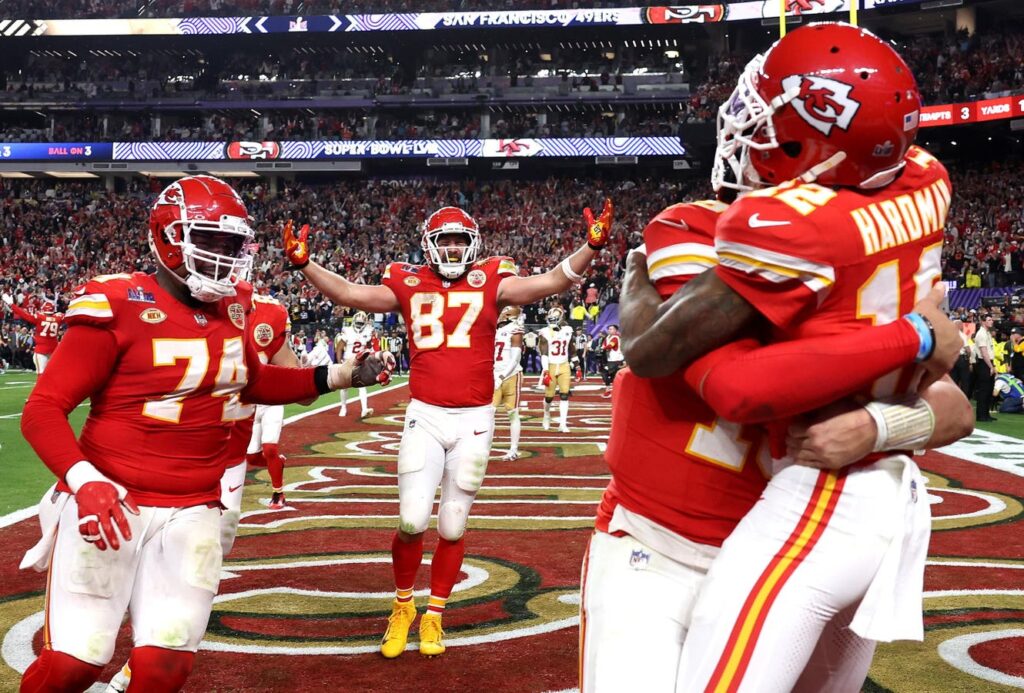LAS VEGAS, NEVADA – FEBRUARY 11: Mecole Hardman Jr. #12 of the Kansas City Chiefs celebrates with … More
Getty ImagesYouTube is steadily taking over the larger concept of “TV,” as the company has regularly called attention to recently. And with over 12% of U.S. streaming viewing, according to April data from Nielsen’s The Gauge, the video platform is the most direct way to deliver content to audiences.
Naturally, the NFL – which owns the largest piece of the TV pie – would want to tap into that. Hence the announcement last week that the Week 1 Friday night matchup between the Kansas City Chiefs and Los Angeles Chargers would appear for free on YouTube.
While it’s not the first time the NFL has streamed a game for free, it’s by far the biggest contest to get that treatment. It’s also the natural extension of the league’s increasing migration to streaming, following Thursday Night Football on Amazon, the launch of NFL+, YouTube nabbing Sunday Ticket rights, Peacock playoff matchups, and Netflix Christmas games.
But those are all gated experiences that successfully test the limits of what NFL fans will pay for games and related content. The league parked games elsewhere and fans followed. Here, you could argue, the NFL is embracing the opposite approach, parking itself (again, for free) where fans already are. And not just any fans, either, but specifically, younger fans.
According to Tubular Labs audience data provided exclusively to Forbes, on average, the NFL’s U.S. YouTube audience is 18.9% viewers 13-to-25. At the peak over the last 13 months, that group hit 10.6 million unique viewers in that age range – 22.7% of the total unique audience.
The NFL’s unique U.S. viewers on YouTube, April 2024-April 2025, compared to share of unique viewers … More
Tubular LabsIt’s a substantial number, even without a live game for those audiences to tune into. By giving younger viewers a live game to watch on a platform they prefer (a Deloitte survey last year said that 60% Gen Z viewers preferred user-generated content – social videos – because it’s easier to find something to watch), you could expect that number to climb. And maybe even convert younger fans in the process, into more regular NFL viewers, when their existing habits of eschewing traditional TV, largely prevent them from watching games at all.
In some ways, it is a familiar path for the league, strategically positioning itself where the proverbial ball is going for TV audiences.
As cable television was beginning its ascent in the late 1980s, live games started appearing on burgeoning networks like ESPN and TNT, and helped fuel their growth and popularity.
The league’s out-of-market play, NFL Sunday Ticket, debuted in 1994 on DirecTV, at a time when satellite TV was in its infancy and the package helped fuel satellite’s explosion (to the point where it was among the primary reasons why AT&T originally acquired DirecTV in 2014).
Parking games on Amazon Prime Video to some extent since 2017, the NFL got ahead of TV’s fast-track move toward ad-supported streaming services. And now, appearing on YouTube, the league cashes in on the platform’s relevance with younger viewers – while also helping push YouTube’s expansion into becoming what more and more audiences (across age breakouts) are considering “TV.”
There’s potential for concern, too, of course.
While consumers will watch billions of hours of YouTube content, much of what’s on the platform (from creators and media companies alike) from a long-form perspective is optimized to both attract and keep audience attention. The NFL, on the other hand, is by default a vehicle for ad deliveries.
Wall Street Journal research from 2010 revealed that despite lasting for over three and a half hours, an NFL game only features about 11 actual minutes of game action. So how do the NFL and YouTube fix that dynamic for this Chiefs/Chargers matchup – on a Friday night, no less, when attention can be hard to come by – especially if it becomes a more lopsided game?
You could argue that on YouTube, and with a younger audience overall, those challenges are even greater than they normally are for a sport that almost encourages channel surfing during lulls. But that also presents an opportunity for creativity: Both in terms of technical delivery and the presentation of the game in a way that keeps viewer engagement high no matter what’s going on within the field of play.
Regardless of how the league (and YouTube) solve for those potential hurdles, expect all eyes to be on how the game’s broadcast plays out; which automatically spells yet another win for the NFL.
Read the full article here


